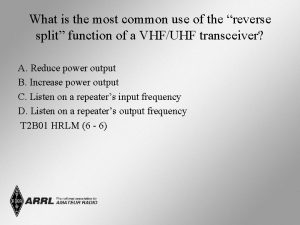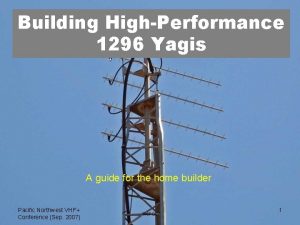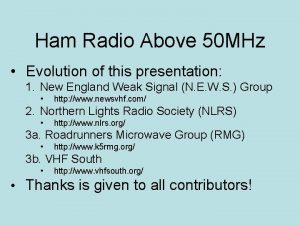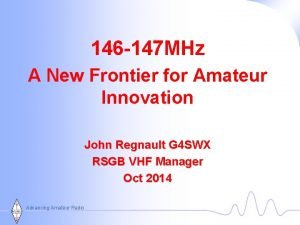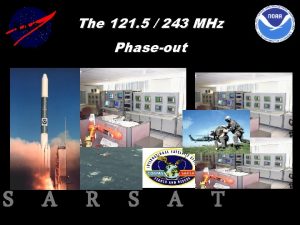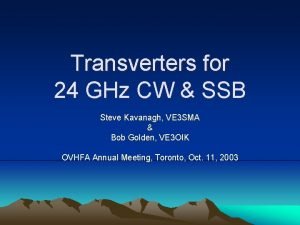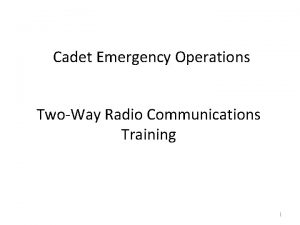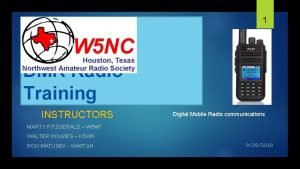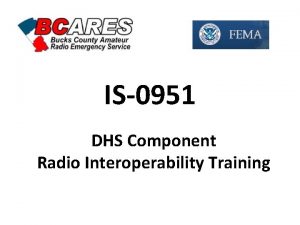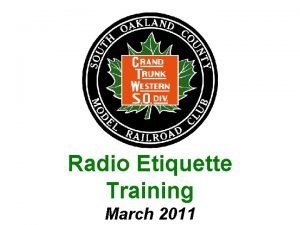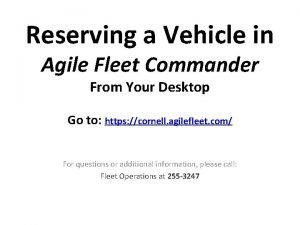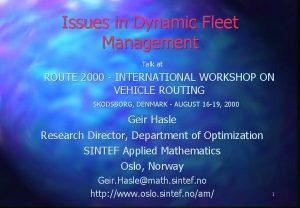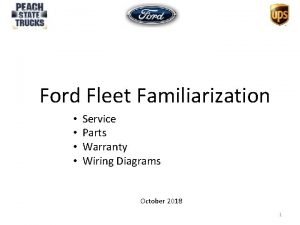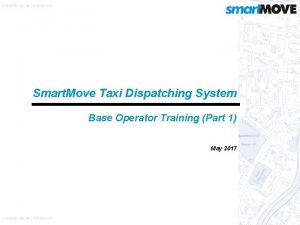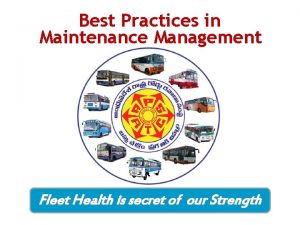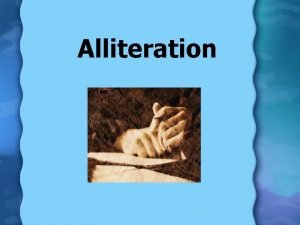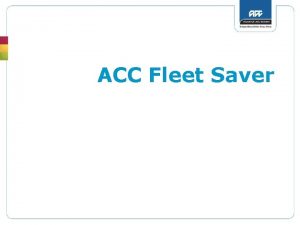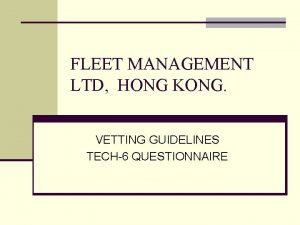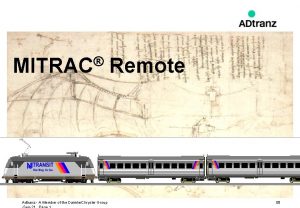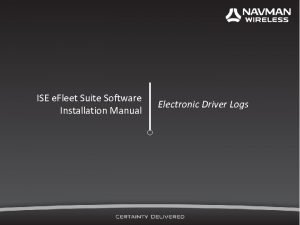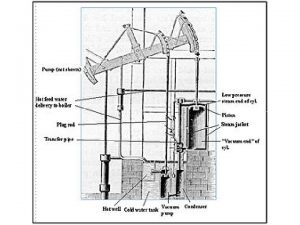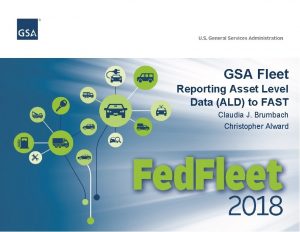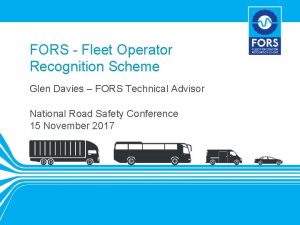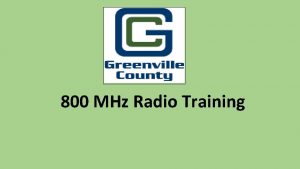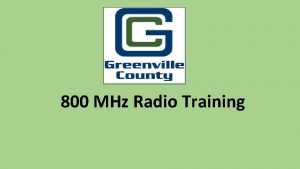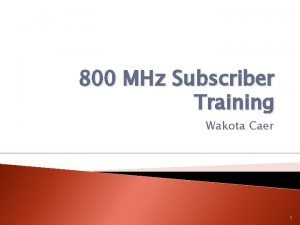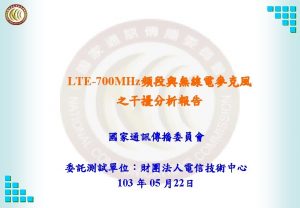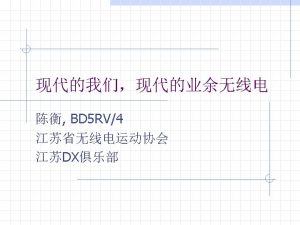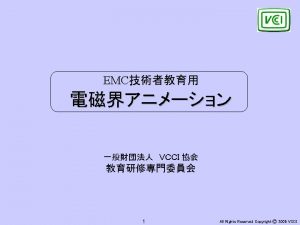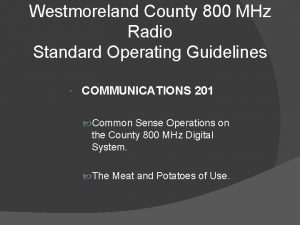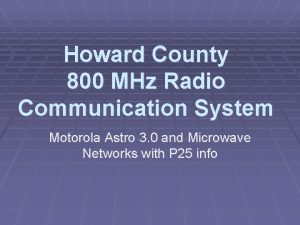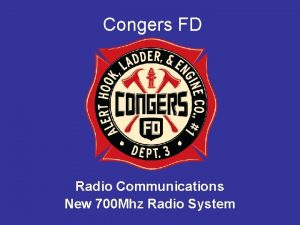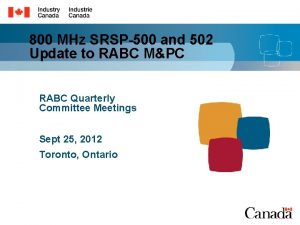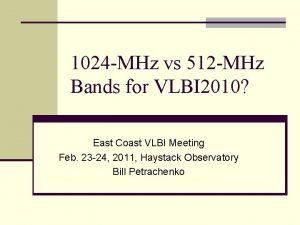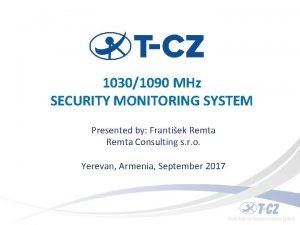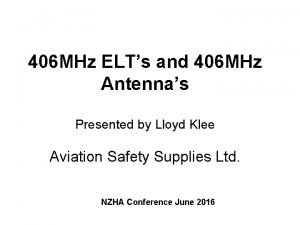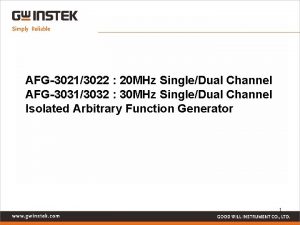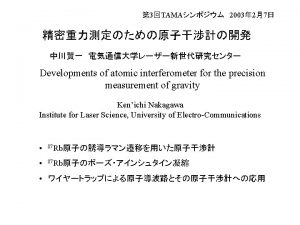800 MHz Radio Fleet Map Update Training Mark


























































- Slides: 58

800 MHz Radio Fleet Map Update Training Mark J. Balistreri Deputy Director Bureau of Public Safety

Highlights • Last Steps of the Rebanding Project • Frequency Changes – 3 Talk-Around – 2 Repeated • Changes in the Fleet Map – Ease of use – Stay in home system – Interoperability

Incident Command System • It is recommended that all agencies use ICS for all incidents • Fleet Map is based on ICS system • ICS Refresher

DISCLAIMER THIS IS NOT AN ICS CLASS • RENSSELAER COUNTY AND ALL COUNTY MUNICIPAL JURISDICTIONS ARE NIMS COMPLIANT. ALL EMERGENCY SERVICES PERSONNEL ARE MANDATED TO TAKE - IS 700 IS 800 ICS 100 ICS 200 ON LINE • http: //www. fema. gov/emergency/nims/ 4

CLASSROOM ICS • SENIOR STAFF • COMMAND STAFF ICS 300 ICS 400 OFFERED BY OFPC AND OEM EVERYONE IS STRONGLY ENCOURAGED TO TAKE APPROPRIATE LEVEL ICS TRAINING 5

INCIDENT COMMAND COMMUNICATIONS • COMMUNICATIONS AND ICS ARE IMPORTANT ELEMENTS OF ADMINISTERING SUCCESSFUL INCIDENT • THE COUNTY 800 FLEET MAP IS SET UP TO ADDRESS THE NEEDS OF ICS • USE THE RADIO SYSTEM TO HELP MANAGE THE INCIDENT USING ICS 6

ICS APPLICATIONS • Fires, HAZMAT, and multi-casualty incidents. • Search & Rescue missions. • Planned events; eg. , parades, celebrations, concerts. 7

Five Primary ICS Management Functions Operations * Logistics Command * Planning Finance/ Administration 8

Functional Responsibilities Of The Incident Commander PLANNING LOGISTICS INFORMATION SAFETY FINANCE / ADMIN LIAISON 9

• COMMAND: Sets objectives and priorities, has overall responsibility for the incident or event. The Incident Commander is responsible for all functions/duties not delegated • Has overall responsibility for accomplishing the missions related to the incident • Primary delegations are the General Staff • Other delegations may include the Command Staff 10

ICS GENERAL STAFF Incident Commander Operations Section Chief Logistics Section Chief Planning Section Chief Finance/ Administration Section Chief 11

OPERATIONS SECTION • IC determines need for separate Operations Section & assigns Section Chief • OPERATIONS: Conducts Tactical Operations to carry out the Plan. Develops the tactical objectives, organization, and directs all resources. • Operations Chief develops & manages Operations Section to accomplish objectives. 12

Operations Section (cont’d) • Operations organization will expand as more resources are brought in. • To allow for expansion & maintain span of control, additional levels of organization can be added: – DIVISIONS – GROUPS – BRANCHES 13

Incident Commander and Command Staff Incident Commander Information Officer Safety Officer Liaison Officer 17 - 11 14

COMMAND STAFF • INFORMATION: Point of contact for the media, or other organizations seeking information. Only one per incident; other agencies can provide assistants. • SAFETY: Monitors safety conditions & develops measures for assuring safety of all assigned personnel. • LIAISON: Point of contact for other agency representatives involved in incident or event. Helps in coordinating their involvement. 15

Span of Control • The number of organizational elements that may be directly managed by another. • Effective Span of Control may vary from three to seven. A ratio of one to five reporting elements is recommended. • Number of individuals that a supervisor can manage effectively 16

DIVISIONS • Established to divide an incident geographically. • Division covering an area on the ground are usually labeled alphabetically. • Within a building, Divisions are normally designated by floor numbers. 17

Geographic Divisions: A B 03 -18. 1 18

Geographic Divisions: Outer Inner 7 6 5 4 3 Perimeter 2 Perimeter 1 03 -18. 2 19

GROUPS • Established to describe functional areas of operation. • Determined by the needs of the incident. • Will work where ever they are needed & will not be assigned to a single Division. • Groups are on equal level as Divisions. 20

Functional Groups: 03 -19 21

Combined Divisions & Groups 03 -20 22

Geographic Branches Functional Branches 03 -21 23

STAGING • Established wherever necessary to temporarily locate resources awaiting assignment. • Should be at an off-site location. • Supervisor assumes title of Staging Area Manager (reports to Operations Section Chief) • Separate staging for different disciplines may be set up, (e. g. , police, fire, EMS, unassigned manpower/personnel). 24

Organization Structure Incident Command Staff Operations Planning Logistics Branch Division Single Resources Task Forces Strike Teams Command Finance/ Administration Branch Group l a i r e g a n Ma Level Section Chief Directors Supervisors Units within Planning Logistics Finance/Administration Units Leaders 03 -03 25

Incident Command Post • The location from where the Incident Commander oversees all incident operations. • Only one ICP per incident or event. • Every incident or event should have this centralized command/control facility. • Must be capable of mobile radio communications 26

Staging Areas • Locations at which resources are kept while awaiting incident assignment. • May be more than one staging area per incident, depending on scope/size of event. • Managed by Staging Area Manager who reports to the Operations Section Chief or Incident Commander. 27

Emergency Operating Centers (EOC’s) • An EOC is a pre-designated facility established by a political subdivision or an agency to coordinate the overall response and support to an emergency. • Provides service & support to incident • Coordinates activities external to immediate impact area 17 - 21 28

• Additional sectors can be assigned a talk group when needed - - For example • EMS REHAB • GEOGRAPHIC DIVISIONS FOR LARGE INCIDENT • HAZ-MAT GROUP • WHEN IC BELIEVES IT APPROPRIATE 29

• ASSIGN DESCRIPTIVE NAMES • AVOID USING “PORTABLE” DESIGNATIONS WHICH CAN BE CONFUSED WITH APPARATUS • CHART ASSIGNMENTS • ALWAYS USE LOCAL CHANNELS FOR INTERIOR OPERATIONS 30

ICS STRUCTURE EXAMPLE INCIDENT COMMAND SAFETY OFFICER LIAISON NYSDEC OPERATIONS HAZ MAT TEAM POLICE EMS CHEMICAL COMPANY FIRE POLICE TRAFFIC SUPPORT TEAM 31

INCIDENT ICS STRUCTURE EXAMPLE COMMAND SAFETY OFFICER OPERATION S POLICE INTERIOR TEAM 1 TEAM 2 VENTILATIO N EMS FIRE POLICE REHAB PERIMETE R BLS STANDBY MAIN & 1 ST ROOF COUNTY STAFF CAUSE AND ORIGIN MAIN & 2 ND WATER FAST SUPPLY 32

OPERATIONS INTERIOR WATER SUPPLY TEAM 1 33 -1 TEAM 2 33 -2 TEAM 3 STAGING ICS STRUCTURE EXAMPLE 33 -3 33

ICS STRUCTURE EXAMPLE INCIDENT COMMAND SAFETY OFFICER EMS OPERATIONS BLS NORTH DIVISION WEST DIVISION RAVINE DIVISION STAGING STANDBY REHAB 34

Fleet Map Version 4. 2 • Highlighted Changes – Lets you stay in home system no matter where you respond – Basic layout is the same • Talk – group changes – Added backup solutions – Added Statewide Operability – Added Traffic Control talk groups

System 1 - EMS • Talk group 1 EMS Dispatch ( 1 -1) – Where you talk to the dispatcher • Talk group 2 Amb to Amb ( 1 -2) – The old 1 -3 • Talk Groups 3/4/5 Ops ( 1 -3/1 -4/1 -5) – Wild cards – for on scene assignment

System 2 – North Fire • Talk group 1 North Dispatch ( 2 -1) – Where you talk to the dispatcher • Talk Groups 2/3/4/5 Ops ( 2 -2/2 -3/2 -4/2 -5) – Wild cards – for on scene assignment – Any one can be the Command Talk Group • Agency assigned – Should be declared by the Commander to the dispatch center

System 3 – Central Fire • Talk group 1 Central Dispatch ( 3 -1) – Where you talk to the dispatcher • Talk Groups 2/3/4/5 Ops ( 3 -2/3 -3/3 -4/3 -5) – Wild cards – for on scene assignment – Any one can be the Command Talk Group • Agency assigned – Should be declared by the Commander to the dispatch center

System 4 – South Fire • Talk group 1 South Dispatch ( 4 -1) – Where you talk to the dispatcher • Talk Groups 2/3/4/5 Ops ( 4 -2/4 -3/4 -4/4 -5) – Wild cards – for on scene assignment – Any one can be the Command Talk Group • Agency assigned – Should be declared by the Commander to the dispatch center

System 12 – East Greenbush • Talk group 1 – East Greenbush Dispatch – Where you talk to the dispatcher • • Talk Group 2 – Best Luther Fire Talk Group 3 – Clinton Heights Fire Talk group 4 – East Greenbush Fire Talk group 5 – Bruen Rescue Squad

Systems 1/2/3/4/12 • Talk group 6 – County Ops North • Talk group 7 – County Ops Central • Talk group 8 – County Ops South – Should be utilized for all mutual aid incidents – Cloned in all five Systems • You can remain in your home System and talk to an agency in another System

Systems 1/2/3/4/12 • Talk group 9 – Special Assignment – Available for use through the dispatcher • When your assigned group is busy • For non – emergency use • Talk group 10 – Traffic Control – Repeated • Must use County approved identifiers • Talk Group 15 – Alert • Talk Group 16 – County Wide

System 5 Local Talk Around • All talk around now in one System – 5 -1 / 5 -2 / 5 -3 • Must be used for on scene and in all hazardous environments • Non repeated – 5 -4 Traffic Control ( non-repeated) – 5 -5 / 5 -6 Back Up (Future Expansion) – 5 -6 Fairbanks Road • For use only when main system does not work

Systems 6/7/8/9 • Reserved for future use

System 10 • Emergency Alert – We all know how to use the big red button

System 11 County • • 11 -1 Highway Main Dispatch 11 -2 Highway Incident 11 -3 Highway Supervisors 11 -4 County Health Department 11 -5 Town Highway Supervisors 11 -9 County Probation 11 -10 County District Attorney

System 13 Law Enforcement • • • 13 -1 Police Dispatch 13 -2 County Sheriff’s Department 13 -3 Car to Car 13 -4 Troy Police 13 -5 East Greenbush Police 13 -6 Hoosick Falls Police 13 -7 Nassau Village Police 13 -8 North Greenbush Police 13 -9 Schodack Police 13 -10 Rensselaer Police

System 14 Police Dispatch Centers • • • 14 -1 East Greenbush 14 -2 Nassau 14 -3 North Greenbush 14 -4 Schodack 14 -5 Rensselaer

System 15 Bureau • • • 15 -1 Fire Investigators 15 -2 Hazmat / Decon 15 -3 Bureau – Dispatch 15 -4 Bureau Management 15 -5 Bureau Staff 15 -6 Bureau Coordinators 15 -7 Emergency Management 15 -8 Search and Rescue 15 -9 Battalion Coordinators 15 -10 EMS Coordinators

System 16 Statewide Interoperability • • • 16 -1 I–Call 16 -2 I-Tac 16 -3 I-Tac 16 -4 I-Tac 16 -5 I-Tac – For use with other agencies that have 800 radios that are not in our System

Low Band Policy • Agencies operating a base station on 46. 10 must provide the Bureau of their current FCC license – Only those with a current license are permitted to operate on 46. 10 – Consistent with 47 CFR 90. 20 FCC Rules and Regs

Low Band Policy • Agencies with FCC licenses to operate on frequencies other than 46. 10 are requested to also provide a copy of their current FCC license for that frequency (s)

Low Band Policy • Any agency that does not hold a current FCC license for a base station operating on 46. 10, and has one, must immediately apply to the FCC for a license. • A letter of concurrence from Rensselaer County Fire Coordinator is required when submitting the license application.

Low Band Policy • Agencies are requested to provide verification of home alert back up arrangements in the event of a county system interruption. This must be in writing by the agencies governing board and must specify if another agency is providing the home alert back up support

Radio Identifiers • No real changes, just some reminders – New identifiers must be approved in writing from the disciple Coordinator • Use the appropriate form – Agencies must utilize the fire police numbering system • Station number then the number 1 then sequential number – Ex. “ 4211, 4212, 4213” – The UID number of the radio is not an identifier – Portables must be properly identified • No homemade identifiers

10 Minute Timer • At each ten (10) minute interval the dispatcher will contact the Incident Commander and advise them how much time has elapsed • The announcement shall be made on Main Dispatch • Will remain in effect until the event is under control or the Incident Commander cancels

10 Minute Timer • Will be implemented January 1 st 2012 • Instituted upon dispatch of a reported structure fire or HAZMAT incident • Time will start at receipt of the emergency call

Field Operations Guide • Updated copy of the guide (CFOG) can be found at – http: //sites. google. com/site/rensselaercountycommunications/home • This is the Radio Committee's web site
 Alternative of log based recovery
Alternative of log based recovery 200+400+600
200+400+600 Where may ssb phone be used in amateur bands above 50 mhz?
Where may ssb phone be used in amateur bands above 50 mhz? 25 mhz band
25 mhz band 1296 mhz loop yagi
1296 mhz loop yagi Meteor scatter 144 mhz
Meteor scatter 144 mhz 147 mhz
147 mhz 121,5 mhz
121,5 mhz A benchmark program is run on a 40 mhz processor
A benchmark program is run on a 40 mhz processor 50 mhz transverter
50 mhz transverter 24 ghz transverter
24 ghz transverter Gsa fleet drive thru
Gsa fleet drive thru Gsa fleet card training
Gsa fleet card training Conventional radio system
Conventional radio system First fleet map
First fleet map Two way radio communication training
Two way radio communication training Brandmeister login
Brandmeister login Radio interoperability web based training
Radio interoperability web based training Radio etiquette training
Radio etiquette training Krismis van map jacobs karakters opsomming
Krismis van map jacobs karakters opsomming Vwfs fleet
Vwfs fleet Gsa drive through
Gsa drive through European leasing market
European leasing market Fleet management plan template
Fleet management plan template Still fleetmanager
Still fleetmanager Cornell fleet services
Cornell fleet services Fleet services uiowa
Fleet services uiowa Fleet performance system
Fleet performance system Emcli db_software_maintenance
Emcli db_software_maintenance Dashboard mobile tracker
Dashboard mobile tracker +fleet +safety
+fleet +safety Dynamic fleet management
Dynamic fleet management Fleet management
Fleet management Fleet ford wiring diagrams
Fleet ford wiring diagrams Fnmoc meteorology products
Fnmoc meteorology products Nedbank fleet card
Nedbank fleet card Roadnet transportation suite manual
Roadnet transportation suite manual Verizon%20vehicle
Verizon%20vehicle Smart move taxi
Smart move taxi Fleet maintenance management system best practices
Fleet maintenance management system best practices Apollo leader vessel
Apollo leader vessel Annata 365
Annata 365 Sports alliteration examples
Sports alliteration examples Acc fleet
Acc fleet Bulk shipping services
Bulk shipping services University of split faculty of maritime studies
University of split faculty of maritime studies Alliiteration
Alliiteration Alliteration in twinkle twinkle little star
Alliteration in twinkle twinkle little star Pg&e ev fleet program
Pg&e ev fleet program Fleet management hong kong
Fleet management hong kong Staples fleet tracking
Staples fleet tracking Fors fleet operator recognition scheme
Fors fleet operator recognition scheme Jessica van fleet green
Jessica van fleet green Daimlerchrysler services fleet management
Daimlerchrysler services fleet management Fleet monash
Fleet monash Fleet suite
Fleet suite First fleet child convicts
First fleet child convicts Gsa fleet drive thru
Gsa fleet drive thru Glen davies
Glen davies


